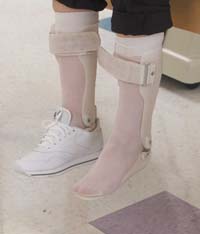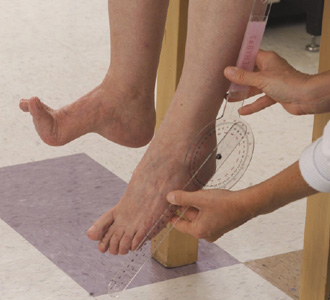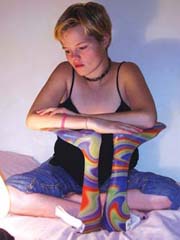
Putting Your Best Foot Forward
Whether or not they're made for walking, happier feet mean a happier you
Though we tend to think of it as something simple, the foot actually is a very complex body part, made up of 26 bones, 33 joints, and more than 100 muscles and tendons. By maintaining the health of this intricate appendage, you can prevent sores, infections or deformities and even wear stylish shoes.
But why should you care about your feet, which you may not even be using if you have a neuromuscular disease? It's easy when you get down to it. Unlike muscle disease, the health of your feet is something you can control. Whether you pamper them at a spa (my preference) or force yourself to wear braces and do foot exercises, keeping your feet healthy holds many benefits.
An uneven pull
All neuromuscular diseases share the common symptom of weak muscles, but each disease has its own quirks. Many foot problems come from having unequal strength in different muscles, says Shree Pandya, a physical therapist and assistant professor of neurology, physical medicine and rehabilitation at the University of Rochester (N.Y.), who works closely with the MDA clinic.
For example, children with Duchenne muscular dystrophy (DMD) may develop plantar flexion contractures, in which their feet point downward due to tightening of the muscles in the back of the calf. (A contracture is an abnormal tightening or fixation of a joint.)
 Foot deformities are more likely to show up in children than in adults, says orthopedic surgeon Irwin M. Siegel, MDA clinic co-director at Rush University Medical Center in Chicago. Those that start in childhood tend to be more severe because children's bones are malleable and designed to grow. When neuromuscular disease causes an uneven and abnormal muscle pull during growth, the foot develops abnormally.
Foot deformities are more likely to show up in children than in adults, says orthopedic surgeon Irwin M. Siegel, MDA clinic co-director at Rush University Medical Center in Chicago. Those that start in childhood tend to be more severe because children's bones are malleable and designed to grow. When neuromuscular disease causes an uneven and abnormal muscle pull during growth, the foot develops abnormally.
Brace yourself
Sure, it's easy to slap a fuzzy pair of socks on your feet and then ignore them until they become swollen and unable to bend. The problem is that you open yourself up to foot deformities, pressure sores, circulatory problems and many other troubles that crop up when you're busy ignoring your feet.
Few people who've worn braces will write poems about how great they are, yet no one I've talked to regretted wearing them.
Lower leg braces, also called AFOs (ankle-foot orthoses), stretch muscles and maintain proper bone structure. They also help prevent contractures to some extent, says Gene Bernardoni, an orthotist (brace specialist) and president of Ballert Orthopedic, who sees patients at the MDA clinic at Rush University.
Like most experts, Bernardoni recommends stretching to keep muscles loose and moving. Although some foot deformity may be inevitable in a neuromuscular disease, bracing and stretching will enable the foot to fit into a shoe — and that's more than a fashion statement. Without the protection shoes provide, feet can be bumped, squished, twisted and fairly beaten up.
Children may wear their AFOs while sleeping, but Bernardoni cautions that they should be left off if they interfere with a child's sleep. Pandya adds the warning that when sleeping in AFOs, children often pull their feet back to relieve the pull on their calf muscles. Added to sitting down all day, this often leads to contractures in their knees.
Physical therapist Wendy King, who works with the MDA clinic at Ohio State University Medical Center in Columbus, points out that there's still much to be learned about ligament and soft tissue development in the foot. Some children can stretch and exercise and wear AFOs all day every day, and still get contractures, while other children might not get them.
As they get older, people adapt their AFO schedules to what works for their feet.
Amanda Van Deusen, 28, wore braces every night until she went to the University of Southern California and met another young woman with spinal muscular atrophy. Van Deusen was surprised to learn that not everyone with SMA wears AFOs forever. The other student agreed that AFOs had kept her feet able to wear her favorite shoes, but that with her growth spurts past, she felt safe just doing stretches.
Seek the advice of your doctor about the use of AFOs.
If the shoe fits...
Although only 5 percent of the general population has flat feet, the problem is more common among people with neuromuscular diseases, Siegel says.
According to the American Academy of Family Physicians, most flat feet are caused by loose joint connections and baby fat between the foot bones. The feet may look like they have arches when the child is sitting or when the big toe is bent backward, but the arch flattens when the child puts weight on the foot.
 As people with neuromuscular diseases age, flat feet can lead to difficulties finding shoes that fit. Wide and double-wide shoes, while not uncommon, are rare in some shoe departments. Yet buying a too-large shoe to fit the width can inadvertently cause injuries because the foot isn't properly protected.
As people with neuromuscular diseases age, flat feet can lead to difficulties finding shoes that fit. Wide and double-wide shoes, while not uncommon, are rare in some shoe departments. Yet buying a too-large shoe to fit the width can inadvertently cause injuries because the foot isn't properly protected.
Pressure sores from ill-fitting shoes also are a problem, King says. See your neurologist or podiatrist right away if you notice sores or skin problems on your feet or ankles.
It's best to be properly fitted for shoes each time you go shopping for a new pair, the American Academy of Orthopaedic Surgeons recommends. The academy also advises trying on shoes later in the afternoon because feet swell as the day goes on.
Some department stores sell a large selection of wide and double-wide shoes to meet every style. Brands such as New Balance, with its broad range of affordable sneakers, and Mephisto, with its selection of rather expensive yet comfortable shoes for all occasions, are known for carrying wide sizes.
Exercise helps
Bones become stronger with use. People weakened by neuromuscular diseases are at risk of developing osteoporosis (in which the bones become extremely porous, are subject to fracture and heal slowly) or osteopenia (bones have decreased calcification and density). Problems stemming from falls, twists, sprains and fractures are common.
Pandya, King and Siegel all agree that exercise can be beneficial. King and Siegel recommend picking objects up with your toes.
Other recommendations include massages, hot and cold baths for circulation, ankle circles and isometric flexing (contracting muscles against resistance such as a wall or another person's hand). Bernardoni also suggests stretching by pushing down on your heel so your toes go up a bit.
Bundle up
One foot problem doesn't become evident until winter. Poor circulation in people who use wheelchairs can lead to sores andchilblains (an inflammation followed by itchy irritation caused by moist cold).
 The key is to keep your feet warm. Siegel says to wear silk hose and/or multiple layers of socks. Avoid heated socks because they can burn your skin. The fashionistas out there can wear UGG boots big sheepskin-lined boots from Australia, secure that they'll keep their feet warm.
The key is to keep your feet warm. Siegel says to wear silk hose and/or multiple layers of socks. Avoid heated socks because they can burn your skin. The fashionistas out there can wear UGG boots big sheepskin-lined boots from Australia, secure that they'll keep their feet warm.
If you notice sores or chilblains, King advises an immediate medical consultation.
A little pampering goes a long way
Often it isn't until feet are injured that they get much attention. Pandya recommends inspecting your feet regularly and seeing a podiatrist if you have any concerns. Dry skin, King says, can lead to skin breakdown.
Herbs and oils in the bathwater can help. For an added level of luxury, soak in a paraffin bath, in which a special wax is melted into a liquid that can soothe cold, stiff feet. Keep toenails trimmed in a straight line not just to prevent snags in your socks; trimming in a curve can cause ingrown toenails.
Although pampering won't cure major sores, regular foot care will head off smaller sores and rashes before they start. Every eight weeks or so, set aside a day to pamper yourself and your feet. Start with King's recommendations of massaging in some oils, then trim your nails, and paint them if you feel like it. (Guys can use the colors of their favorite football teams.)
I have to admit that in the past I've treated my feet as little more than decoration. As I researched this article, it became apparent that I'd indeed been doing some things the hard way (such as buying ill-fitting shoes) that led to rashes. I also recognized that I'd found some obvious solutions on my own — for instance, I keep a space heater in my room to increase circulation in my legs.
Don't put aside the things you've found that work with your style as long as they keep your feet healthy. You're far more likely to keep up a daily pattern if it doesn't throw off your whole life.
Of course, an afternoon pedicure wont throw your life off too badly, and you can always say it's for medical reasons.
Abby Albrecht is a freelance writer, Web designer, and lover of sassy shoes and spas, who lives near San Francisco. She has SMA type 2.
Tips for Good Foot Care
- Keep your toenails trimmed. Straight-trimmed nails will prevent ingrown toenails and scratches that could become infected.
- Don't force your foot into a shoe. If your foot is squeezed or pushed into uncomfortable positions you risk creating sores.
- Keep your feet warm and dry. Athlete's foot can happen to you even if you never enter a gym.
- When you hear a good song, tap your feet. It may not look as if your toes are even moving, but it encourages circulation and burns off extra energy.
- Don't be afraid to show off your feet. You're more likely to pay attention to potential problems if you wear shoes that feature your feet.
MDA Resource Center: We’re Here For You
Our trained specialists are here to provide one-on-one support for every part of your journey. Send a message below or call us at 1-833-ASK-MDA1 (1-833-275-6321). If you live outside the U.S., we may be able to connect you to muscular dystrophy groups in your area, but MDA programs are only available in the U.S.
Request Information